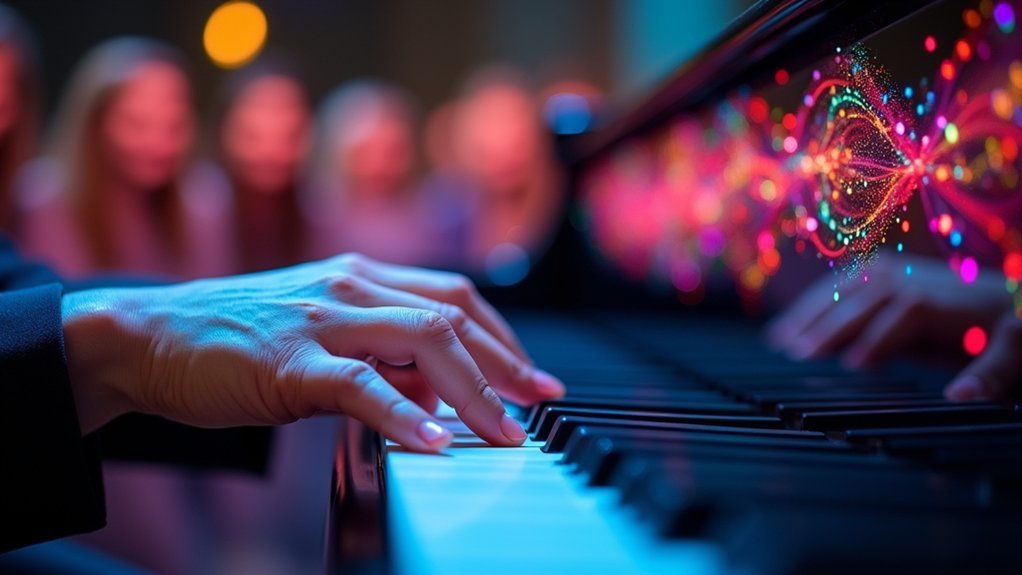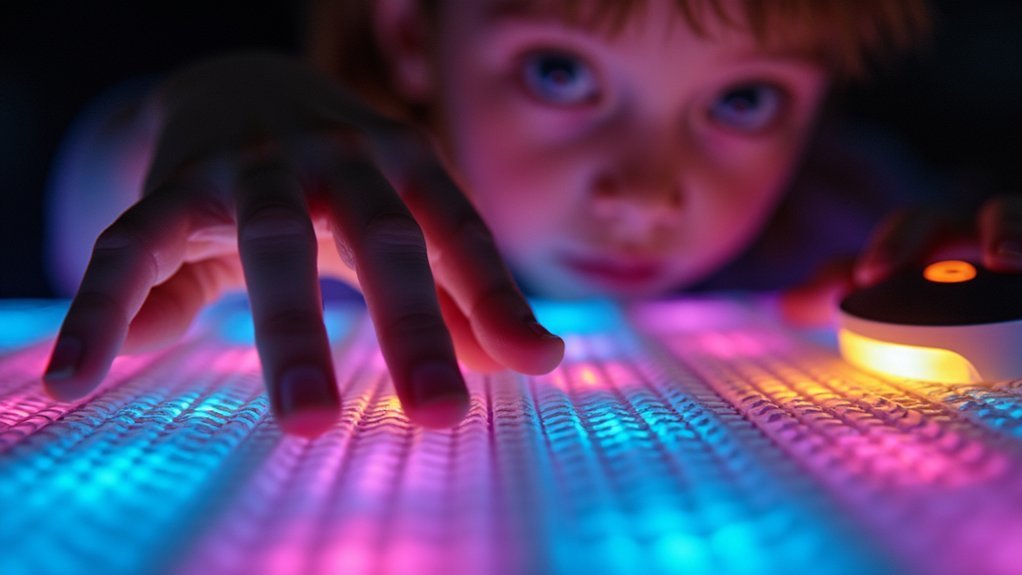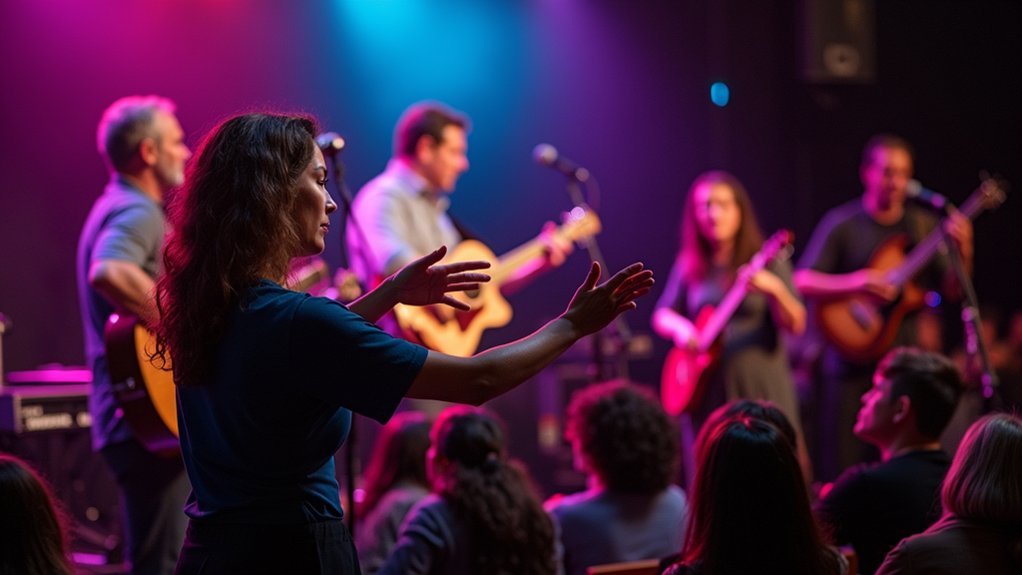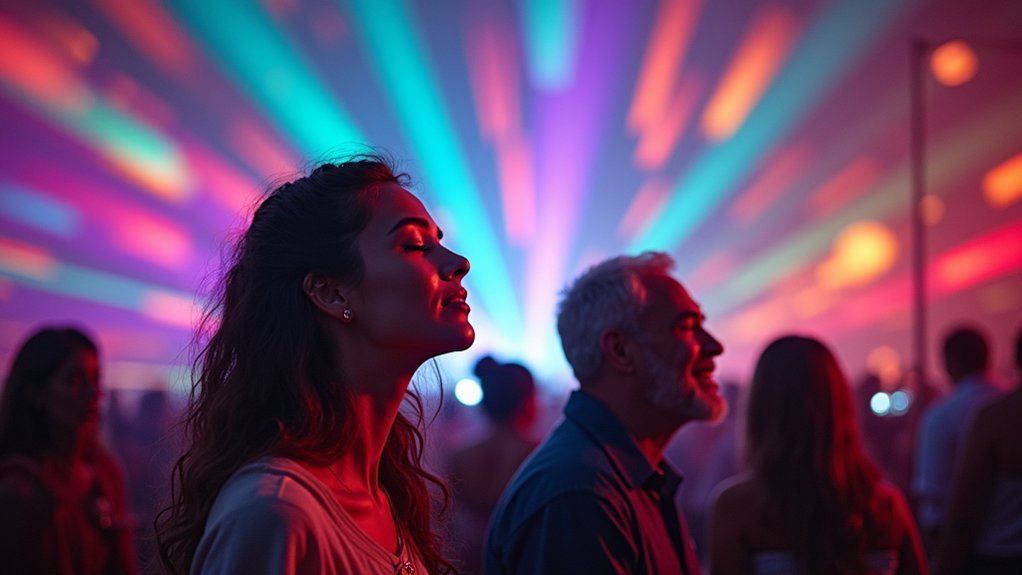Visual cues transform music for hearing-impaired individuals by activating alternative neural pathways. Your brain’s visual processing centers can interpret rhythm and tempo through synchronized lights, color-coded notations, and expressive sign language interpretation. These visual elements work alongside vibrotactile technology that converts sound into physical sensations you can feel through your skin. This multi-sensory approach creates a richer musical experience, helping you connect emotionally with performances. The science behind these innovations reveals how music transcends traditional listening.
The Neuroscience Behind Visual Processing of Musical Elements

While most people think of music as primarily an auditory experience, the brain’s visual processing centers actually play a remarkable role in how we perceive musical elements. When you’re hearing-impaired, your occipital lobe becomes especially important, helping interpret visual cues that enhance musical understanding.
Fascinatingly, visual stimuli like vibrations and movement can activate your auditory cortex, allowing you to perceive rhythms and structure through sight rather than sound. Neuroimaging studies confirm increased connectivity between visual and auditory brain regions when you engage with visual music cues.
This multimodal approach to music perception means you can experience timing and dynamics visually. Visual elements like light displays or sign language interpretations greatly improve emotional responses to music.
This compensation mechanism explains why visual cues are transformative, not merely supplemental, for hearing-impaired music lovers.
Light-Synced Instruments: Bridging Sound and Sight
You’ll discover how pulsing LEDs enhance rhythm perception, creating visual pathways that connect DHH musicians to tempo and beat structures otherwise inaccessible through traditional means.
Color-coded percussion patterns transform abstract musical concepts into concrete visual experiences, allowing you to “see” the difference between a snare hit and a bass drum.
These technological innovations represent more than accessibility tools—they’re reshaping music education and performance by offering synchronized light-based interpretations of sound that benefit musicians across all hearing abilities.
Subheading Discussion Points
Light-synced instruments represent a revolutionary breakthrough in making music accessible to Deaf and Hard-of-Hearing (DHH) individuals. These LED-based tools transform auditory elements into dynamic visual patterns, allowing you to experience rhythm and melody through sight rather than sound.
When you attend live music events featuring light-synced performances, you’ll notice how visual cues dramatically enhance music experiences for DHH audiences. Research confirms this approach works—combining vibrations with visual stimuli creates a more immersive connection to the music.
For Deaf people, these instruments offer more than entertainment; they’re potential tools for music therapy and education. The multisensory approach helps you form emotional connections with music that weren’t previously possible.
Pulsing LEDs Enhance Rhythm
The pulsing LEDs in light-synced instruments transform invisible rhythm into visual beats you can follow with your eyes. These visual cues create a multisensory experience where you don’t just watch music—you understand it through synchronized light patterns that represent tempo and rhythm.
For you as a hearing-impaired individual, these technological innovations offer significant benefits:
- Lights that pulse in perfect time with musical beats enhance your rhythm perception without relying on sound.
- Visual representation of tempo changes helps you connect emotionally with the performance’s dynamics.
- Combined with haptic feedback, you can literally feel the music while seeing its structure.
Research confirms these technologies dramatically improve your ability to participate in live performances, making musical experiences more accessible and enjoyable through creative visual translation.
Color-Coded Percussion Patterns
When percussion instruments illuminate with vibrant color patterns synchronized to each drum strike, they create a visual language that transcends traditional hearing barriers. You’ll discover these color-coded patterns transform music appreciation for hearing-impaired individuals by translating rhythm into visual cues.
| Instrument | Color Pattern | Benefit |
|---|---|---|
| Bass Drum | Deep Blue Pulse | Establishes fundamental beat |
| Snare | Bright Red Flash | Highlights accent notes |
| Cymbals | Gold Shimmer | Shows sustained sounds |
| Tom-toms | Green Gradient | Indicates melody patterns |
| Shakers | Purple Waves | Represents texture elements |
This technology doesn’t just improve engagement—it creates an inclusive environment where all musicians participate equally. Research confirms these visual representations enhance learning and emotional connection to music, making complex rhythmic structures accessible through synchronized light displays.
Color-Coded Musical Notation Systems for Enhanced Accessibility
Color-coded musical notation systems have revolutionized music accessibility by transforming abstract auditory concepts into concrete visual experiences for hearing-impaired individuals.
These visual cues create a multisensory experience that bridges the gap between auditory and visual learning styles, making music education more inclusive.
When you use color-coded musical notation, you’ll notice:
- Improved retention and understanding of musical concepts
- Enhanced ability to follow compositions during group activities
- Greater collaboration between hearing-impaired and hearing students
Research confirms that these systems greatly boost comprehension for hearing-impaired learners by associating specific colors with notes or rhythms.
This approach doesn’t just enhance accessibility—it creates a more equitable learning environment where all students can participate meaningfully, regardless of hearing ability.
Vibrotactile Feedback: When You Feel What You Cannot Hear

Vibrotactile technology transforms musical elements into physical sensations you can feel across your skin, creating a bridge between auditory and tactile senses.
Your entire body becomes an instrument for experiencing music as specialized wearable devices translate rhythm, pitch, and intensity into precisely mapped vibrations.
These innovations, from haptic vests to wristbands, now enable you to perceive music’s emotional nuances through touch, revolutionizing accessibility for hearing-impaired listeners.
Sensory Information Translation
Though often overlooked, the skin serves as a remarkable receptor for experiencing music beyond traditional auditory channels. Through sensory substitution, vibrotactile feedback translates sound waves into tactile sensations you can feel, creating a bridge between music and hearing loss. This process transforms auditory information into physical vibrations that enhance music experience for deaf individuals.
- Your body can detect musical rhythm, pitch, and loudness through specialized haptic devices like the “Haptic Chair” or wearable sleeves.
- Visual cues work alongside tactile feedback to create a thorough multisensory music experience.
- Research shows you can identify beats and melodies through skin contact, perceiving musical nuances that audio alone wouldn’t communicate.
This translation of sensory information opens new pathways for connecting with music’s emotional content, regardless of hearing ability.
Full-Body Musical Experience
Imagine feeling music rippling across your skin—this is now possible through haptic devices that transform what you can’t hear into what you can feel. For Deaf or Hard of Hearing individuals, vibrotactile feedback creates a genuine full-body experience, converting sound waves into meaningful tactile sensations.
Research confirms these devices effectively map musical elements like rhythm, pitch, and loudness onto your body.
When paired with visual cues, innovations like the “Haptic Chair” deliver real-time rhythm information, allowing you to experience music’s emotional core. Your music perception extends beyond traditional boundaries as these technologies engage your entire sensory system.
The vibrations dancing across your skin enhance music engagement in profound ways, enabling you to connect with musical compositions on a deeper level—transforming passive listening into active, full-body participation.
Wearable Technology Innovations
The latest wearable innovations are transforming how hearing-impaired individuals experience music through their skin. Vibrotactile feedback devices convert audio signals into tactile sensations, allowing you to feel music through specialized haptic wearables like vests and wristbands.
These systems enhance your music experience by mapping musical elements in ways your body can process:
- Rhythmic patterns become pulsations that help you follow the beat and timing
- Melodic changes translate to varying vibration intensities across different body locations
- Visual cues complement tactile feedback for a multi-sensory experience
Research confirms that hearing-impaired users develop unique music processing abilities through these technologies.
Affordable wearable haptic devices now make this accessible, creating immersive connections to music that were previously impossible—proving that music appreciation extends far beyond traditional hearing.
Sign Language Interpretation in Musical Performance

When musical performances incorporate sign language interpretation, they transform into multi-sensory experiences that welcome Deaf and Hard of Hearing (DHH) audiences into spaces traditionally designed for hearing individuals.
Music becomes a universal language when sign interpretation transforms performances into vibrant visual symphonies for all audiences.
You’ll notice skilled interpreters don’t merely translate lyrics—they convey the emotional tone through expressive movements, facial expressions, and visual storytelling techniques.
This accessibility revolution has gained significant traction as music lovers of all hearing abilities seek more inclusive experiences. For deaf audience members, these interpretations create deeper connections to the music’s narrative and emotional nuances.
Research confirms that DHH concert-goers report greater engagement and satisfaction when interpreters are present.
Beyond serving DHH individuals, this practice fosters broader awareness and appreciation of Deaf culture within musical communities, creating a more inclusive environment where everyone can share the joy of live performances.
Technological Innovations Reshaping Musical Experiences for the Hearing-Impaired
Beyond the expressive power of sign language interpreters, a wave of technological breakthroughs is fundamentally altering how hearing-impaired individuals experience music. Advanced hearing aids and cochlear implants now offer improved pitch recognition, transforming your ability to perceive musical nuances.
Visual music experiences have evolved dramatically through:
- Smart glasses providing real-time lyric displays with 95% accuracy
- LED systems that sync with audio, creating dynamic visual representations
- Haptic feedback devices that convert sound waves into vibrations you can feel
Innovative AI-powered tools now customize musical experiences to your preferences, while immersive VR environments are making music videos more accessible.
These technological innovations bridge sensory gaps, offering you multiple pathways to connect with music’s emotional power, regardless of hearing ability.
Frequently Asked Questions
What Are the Benefits of Visual Cues?
Visual cues benefit you by enhancing emotional connections, creating multisensory experiences, conveying rhythm through visualization, complementing tactile stimuli, and improving overall engagement. They’re especially valuable when you’re processing information that typically relies on audio.
How to Make Music Accessible to Deaf People?
You can make music accessible to deaf people through sign language interpreters, haptic feedback devices that create vibrations, visual displays that sync with beats, and supportive communities that share music experiences through sign language.
How to Improve Hearing Loss Due to Nerve Damage?
You can improve nerve-related hearing loss by using advanced hearing aids, considering cochlear implants, pursuing auditory training, and exploring speech therapy. Stay updated on regenerative medicine options like gene therapy and stem cell treatments.
What Are the Uses of Visual and Auditory Cues?
Visual and auditory cues help you process information more effectively. You’ll use them for communication, navigation, learning, and safety alerts. They’re especially valuable when you’re multitasking or have sensory processing differences.
In Summary
You’re witnessing a revolution in music accessibility. Through neuroscience, light-synced instruments, color-coded notation, vibrotactile feedback, sign language performances, and emerging technologies, you’re able to experience music beyond traditional hearing. These visual and tactile cues don’t just compensate for hearing loss—they’re creating entirely new ways to connect with music’s emotional power. You’ll find that music isn’t just something you hear; it’s something you see, feel, and experience holistically.





Leave a Reply